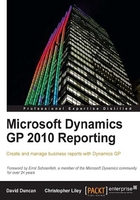
What this book covers
Chapter 1, Meeting the Reporting Challenge: Our opening chapter will provide commentary on the many challenges and frustrations a company may face when preparing to build new reports. Developers tasked with report creation must be aware of these challenges and select the most effective reporting tool, or tools, to satisfy the company's reporting needs. In addition to using the discussion of challenges faced with reporting as a springboard for the rest of the book, this chapter will also provide commentary on recent reporting trends in the Dynamics GP space.
Chapter 2, Where Is My Data and How Do I Get To It?: Before we can begin utilizing many of the reporting tools covered in this book, we must have a better understanding of how Dynamics GP stores data. This chapter will provide users with helpful tips for finding and locating their data in the GP system and company databases. Knowing where to begin is a critical first step for any technical resource setting out to develop a new report, and this chapter aims to make the process of beginning a new report an easier one.
Chapter 3, Working with the Builders: SmartList and Excel Reports: This chapter begins our discussion of our first reporting tools as we introduce the SmartList and the "Builders": SmartList Builder and Excel Reports Builder. Users will briefly review how to use basic SmartLists for simple reporting. Readers will learn how to deploy the Excel Reports that duplicates the SmartList favorites in Excel format and offers a live data connection that makes the reports instantly refreshable. The final half of this chapter will focus on using SmartList Builder and Excel Reports Builder tools to create additional reports beyond the standard SmartList/Excel favorites.
Chapter 4, Report Writer: This chapter covers the built-in report-writing function of GP 2010 known as Report Writer. This chapter on Report Writer will introduce the reader to the basic layout and the various functions of Report Writer. By the end of this chapter, readers should be familiar with making basic modifications to standard GP reports. Additionally, readers will be exposed to the capabilities and limitations of the new GP 2010 Word Template functionality that allows existing reports to be rendered in Microsoft Word format.
Chapter 5, SSRS Report Library: This chapter introduces the concept of utilizing the well-known SQL Server Reporting Services (SSRS) tool with Dynamics GP data. This chapter opens with tips for installing SSRS in your environment before moving into a discussion on deploying the pre-defined SSRS Reports and Metrics designed specifically for GP 2010. Finally, we will cover the use of Visual Studio to make modifications to existing SSRS reports as well as to create new Report Metrics and KPIs that can be deployed on the GP 2010 Home Page.
Chapter 6, Designing Your Analysis Cubes for Excel Environment: This is the first of two chapters which will cover the extensive Analysis Cubes for Excel reporting tool. This chapter will cover the installation of Analysis Cubes and provide details on the various components that are created by the installation. Finally, this chapter will cover some simple modifications that can be made to the Analysis Cubes data warehouse and Analysis Services database to improve the end-user reporting experience.
Chapter 7, Utilizing Analysis Cubes for Excel for Dynamic Reporting: Many readers will be familiar with some of the concepts discussed in the early portion of this chapter. Excel PivotTables are widely used throughout many organizations, even those without GP 2010, but the first part of this chapter will explore the use of PivotTables specifically with the Analysis Cubes for Excel product. From here, we will explore the use of the lesser-known CUBE formulas that prove to be a useful skill-set to know when building static reports and dashboards based on Analysis Cubes data.
Chapter 8, Designing Financial Reports in Management Reporter: Like Analysis Cubes for Excel, content for the Management Reporter tool will span multiple chapters. This chapter will introduce readers to Management Reporter and basic report design. We will provide an overview of Management Reporter installations before providing tips for navigating the Management Reporter layout. Finally, this chapter will cover the use of the various building blocks of Management Reporter for report creation.
Chapter 9, Viewing Financial Reports in Management Reporter: This chapter continues the discussion on Management Reporter begun in Chapter 8. Here, we will cover information related to the Report Viewer component of Management Reporter. In addition to discussion on report-generation, this chapter also provides information on managing reports through the use of report packages and version control. Finally, this chapter provides some commentary on the differences between FRx and Management Reporter.
Chapter 10, Bringing It All Together: This chapter brings our book to a close by combining the discussion of reporting challenges and trends broached in Chapter 1 with the reporting tools discussed in the remaining chapters. Here, we will consider each challenge in light of the various reporting tools. By the end of this chapter and book, readers will not only be familiar with each reporting tool, but they will have a better understanding of how and when each reporting tool can be used most effectively in their organization.
Appendix A, Comparing the Dynamics GP Reporting Tools Against Different Reporting Challenges: The final section of this book contains a helpful table that can be used as a quick reference guide to see how the reporting tools measure up to the various reporting challenges we have already discussed. By presenting this data in table format, readers can quickly scan across a row to see how each tool meets a particular challenge, or they can scan down a column to see how a single reporting tool measures against each individual challenge.